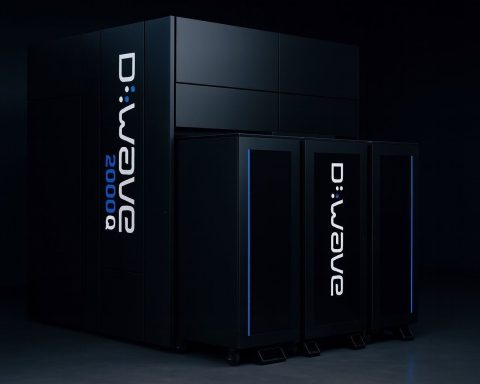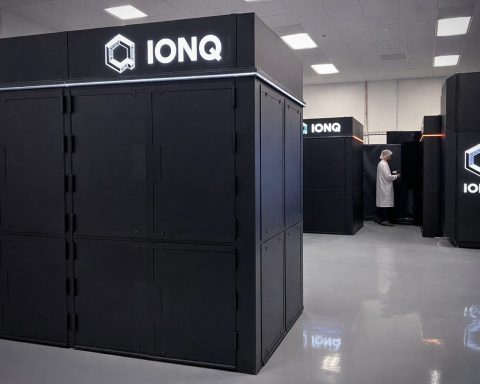- Fujitsu announced R&D on a superconducting quantum computer with over 10,000 physical qubits, targeting completion in fiscal 2030, using its STAR fault-tolerant architecture to reach 250 logical qubits by 2030 and 1,000 logical qubits by 2035 as part of a Japan-backed industrialization effort.
- IonQ and Oak Ridge National Laboratory demonstrated a quantum-enhanced power-grid optimization using IonQ’s 36-qubit Forte system to schedule 26 generators over 24 periods, as part of the DOE GRID-Q program.
- Rigetti Computing announced 99.5% median two-qubit gate fidelity on its 36-qubit modular processor (four 9-qubit chiplets), plans to launch the system on August 15 and to scale to over 100 qubits with the same fidelity by the end of 2025.
- D-Wave released the Quantum AI Toolkit, an open-source set of tools to connect D-Wave’s annealing processors to PyTorch for training models like restricted Boltzmann machines, with early collaborators achieving improvements in drug discovery and simulations.
- The Cambridge and Université Paris-Saclay team unveiled a molecule that directly couples an electron spin to the color of emitted light, with a triplet state emitting orange and a singlet state emitting near-infrared, enabling optical readout of spin.
- French researchers from C12 Quantum Electronics and École Normale Supérieure achieved a record 1.3 microsecond coherence time for an electron-spin qubit in a carbon nanotube double quantum dot at 0.3 K, read via a microwave cavity using isotope-pure 12C.
- CERN’s BASE collaboration demonstrated an antiproton qubit, maintaining a coherent superposition for about 60 seconds, enabling tests of CPT symmetry and potential quantum sensing applications.
- SpinQ Technology raised several hundred million RMB in a Series B to fund its 100-qubit chip development and global expansion, with over 200 universities and institutions in 40+ countries using its devices.
- Israeli startup QuamCore announced a $26 million Series A to build the world’s first million-qubit quantum computer, claiming a superconducting architecture capable of 1,000,000 qubits in a single cryostat and plans to fabricate first-generation processors.
- South Korea’s Qunova secured a 13.5 billion won (~$9.7 million) Series A to advance its HI-VQE Hybrid Quantum Optimization platform, with prior demonstrations achieving chemical accuracy on a 20-qubit system and 6G network optimization with LG U+.
Over the past two days, the quantum computing world has been buzzing with major announcements, scientific milestones, strategic investments, and bold predictions. From corporate leaps and technical breakthroughs to government initiatives and expert commentary, here’s a comprehensive roundup of all notable quantum computing developments from August 4–5, 2025. Global tech companies unveiled ambitious plans, researchers set new records, startups secured funding, policymakers advanced quantum agendas, and thought leaders weighed in on the quantum future versus hype. Below, we break down the key developments by category, with direct quotes and sources for each item.
Industry Moves (Corporate Announcements & Tech Milestones)
- Fujitsu’s 10,000-Qubit Roadmap: Kicking off this week, Fujitsu officially announced it has begun R&D on a superconducting quantum computer with over 10,000 physical qubits, targeting completion in fiscal 2030 [1]. The system will use Fujitsu’s new “STAR” fault-tolerant architecture to achieve 250 logical qubits by 2030 and 1,000 logical qubits by 2035 as part of a Japan-backed project to industrialize quantum tech [2]. “By realizing 250 logical qubits in fiscal 2030 and 1,000 logical qubits in fiscal 2035, Fujitsu is committed to leading the path forward globally in the field of quantum computing,” said Fujitsu CTO Vivek Mahajan [3], noting plans to later integrate superconducting and diamond-spin qubits.
- IonQ & ORNL Optimize the Power Grid: In a notable public-private demo, IonQ and Oak Ridge National Lab revealed they solved a complex power grid optimization (unit commitment) problem using a hybrid quantum-classical approach on IonQ’s 36-qubit “Forte” system [4] [5]. The quantum-enhanced method found optimal generator schedules for a 26-generator, 24-period task that is intractable for classical algorithms [6] [7]. “This demonstration marks a significant milestone in applying quantum computing to real-world energy challenges,” said IonQ CEO Niccolo de Masi, who noted that as IonQ’s hardware scales to “thousands and millions of qubits,” they expect to solve grid optimization problems beyond classical reach [8]. ORNL’s project lead Suman Debnath added that this case study on today’s device proved feasibility, and as the quantum hardware improves, researchers will test for true quantum advantage in grid operations [9]. Part of the U.S. DOE’s GRID-Q program, this positions energy grid management as an early use-case for quantum optimization.
- Rigetti Hits 99.5% Fidelity Milestone: Quantum hardware startup Rigetti Computing announced a major performance breakthrough – achieving 99.5% median two-qubit gate fidelity on its newest modular 36-qubit superconducting processor [10]. This marks a twofold reduction in error rate compared to Rigetti’s prior 84-qubit chip and meets its mid-year goal for error correction thresholds. The 36-qubit device is composed of four 9-qubit “chiplets” tiled together, a multi-chip architecture that paves the way for a >100-qubit system by year-end (with the same 99.5% fidelity target) [11] [12]. “By leveraging well-known techniques from the semiconductor industry, we’ve developed proprietary technology that we believe is critical to enable scaling to higher qubit count systems,” explained Rigetti CEO Dr. Subodh Kulkarni, noting the advantages of fast superconducting qubits and modular chips for scalability [13]. Rigetti plans to launch the new 36-qubit system on August 15 and remains on track to deliver a 100+ qubit machine at 99.5% fidelity by the end of 2025 [14] [15].
- D-Wave’s Quantum AI Toolkit: D-Wave released new open-source developer tools aimed at integrating quantum computing into machine learning workflows [16]. Part of D-Wave’s Ocean software suite, the toolkit lets developers use D-Wave’s annealing quantum processors within PyTorch for training certain AI models (e.g. restricted Boltzmann machines for generative tasks) [17] [18]. Early collaborators including Japan Tobacco, the Jülich Supercomputing Centre, and Canada’s TRIUMF achieved promising results – such as improved training speed or accuracy versus purely classical methods – in drug discovery, protein-DNA binding analysis, and physics simulations [19] [20]. “With this new toolkit and demo, D-Wave is enabling developers to build architectures that integrate our annealing quantum processors into a growing set of ML models,” said Dr. Trevor Lanting, D-Wave’s Chief Development Officer [21]. The toolkit directly connects D-Wave’s quantum systems to the popular PyTorch framework, aiming to make experimentation with quantum-assisted AI more accessible to data scientists [22] [23].
Academic Breakthroughs (Research & Publications)
- Molecule Links Spin to Light: A joint team from the University of Cambridge (UK) and Université Paris-Saclay (France) unveiled a novel carbon-based molecular material that directly couples an electron’s spin state with the color of light it emits [24] [25]. In a paper in Nature Chemistry, the researchers engineered an organic diradical molecule with two unpaired electron spins that can align either in the same direction (triplet state) or opposite (singlet state). Remarkably, the molecule’s fluorescence changes hue depending on the spin alignment: when the two spins align (triplet), it emits visible orange light; when anti-aligned (singlet), it emits near-infrared light [26]. “This allows you to very easily detect and know the quantum state of the molecule just by looking at the colour,” explained first author Rituparno Chowdhury, a Cambridge PhD student [27]. By providing a direct optical readout of a molecule’s spin, this research demonstrates a much simpler, cheaper approach to quantum spin sensing than using exotic materials like NV-diamond. The discovery opens a new path toward low-cost, light-based quantum devices and sensors, where information encoded in electron spins can be read out via the emitted photon’s color.
- Record-Long Qubit Coherence in Carbon: French researchers at startup C12 Quantum Electronics and the École Normale Supérieure achieved a record 1.3 microsecond coherence time for an electron-spin qubit in a carbon nanotube circuit [28]. This is about 100× longer than prior carbon-based qubits and 10× longer than typical silicon spin qubits under similar conditions [29] [30]. Published in Nature Communications, the experiment used a suspended, ultraclean ^12C nanotube double quantum dot integrated in a microwave cavity at 0.3 K [31] [32]. By eliminating nuclear-spin noise (using isotope-pure carbon) and suspending the nanotube with no substrate, the team drastically reduced environmental decoherence [33]. Uniquely, they controlled the qubit via cavity photons instead of any external magnetic fields, further suppressing noise [34]. Operating at a relatively “warm” 300 mK, the device maintained quantum coherence for orders of magnitude longer than previous carbon qubits. The result revives interest in carbon nanotubes as a platform for scalable quantum processors, matching or exceeding coherence times of many silicon qubits [35] [36]. It sets a new benchmark for hybrid spin-photon devices in circuit QED, suggesting that with “clean” carbon materials plus clever engineering, carbon-based qubits could become serious contenders in the race for longer-lived, high-fidelity qubits [37] [38].
- Antimatter Qubit Demonstrated at CERN: In a breakthrough for fundamental physics, the BASE collaboration at CERN successfully used an antiproton as a functional qubit, maintaining a single antiproton in a coherent quantum superposition of two spin states for nearly one minute [39] [40]. Detailed in Nature, the researchers trapped an antiproton (the antimatter counterpart of a proton) and induced transitions between its two spin orientations, observing quantum Rabi oscillations that persisted for ~60 seconds [41] [42]. Achieving such prolonged coherence with an antimatter particle is unprecedented – ambient interactions usually destroy quantum states far quicker. The team’s technique, coherent quantum transition spectroscopy, enabled precise measurement of the antiproton’s magnetic moment flips while preserving quantum interference for an extended duration [43]. This milestone will allow far more sensitive tests of fundamental symmetries like CPT (charge-parity-time symmetry), which predicts matter and antimatter should have identical properties [44] [45]. By controlling and reading out an antimatter qubit, researchers also hint at potential applications in quantum sensing and information processing, though the primary impact is probing the limits of physics. The ability to trap and manipulate antimatter quantum states opens a new frontier for comparing matter vs. antimatter with high precision – a step toward understanding the universe’s matter-antimatter imbalance.
Regulatory and Policy Updates
- U.S. Pushes for Quantum-Proof Encryption: In Washington, U.S. senators Gary Peters and Marsha Blackburn introduced the National Quantum Cybersecurity Migration Strategy Act on August 1 – a bipartisan bill to ensure federal agencies prepare for the day quantum computers can break current encryption [46] [47]. The proposed law directs the White House OSTP to develop a coordinated roadmap for migrating government systems to post-quantum cryptography and mandates that each federal agency quantum-proof at least one high-impact IT system as a pilot project [48] [49]. It builds on the 2018 National Quantum Initiative and 2022 Quantum Cybersecurity Act, reflecting growing concern about the looming “Q-day” when powerful quantum machines could jeopardize classical RSA encryption [50]. “It’s critical that the federal government be prepared for any threat posed by quantum computing technology, especially when it concerns our national security,” said Senator Peters, who co-sponsored the bill [51]. By starting the transition now – even though code-breaking quantum computers are still years away – lawmakers aim to avoid a last-minute scramble to secure sensitive data in the future. The bill would leverage existing expert groups (like an interagency ESIX subcommittee) to guide the migration and set performance benchmarks for quantum-resistant security [52] [53].
- India’s $20 B Quantum Mission (Karnataka): In India, the state government of Karnataka (home to tech hub Bengaluru) launched an ambitious ₹1,000 crore (~$114 million) “Karnataka Quantum Mission” as a roadmap to create a $20 billion quantum economy by 2035 [54] [55]. Unveiled by Chief Minister Siddaramaiah at the Quantum India 2025 summit in Bengaluru, the plan rests on five pillars: talent development (quantum education in 20+ colleges and 150 PhD fellowships yearly), R&D and pilots (developing a 1,000-qubit homegrown processor around 2030 and piloting quantum tech in healthcare, security, etc.), infrastructure (establishing India’s first Quantum Hardware Park plus four innovation zones and a chip fab facility by year-end), industry support (funding 100+ startups, filing 100+ patents, and creating a state-backed Quantum VC Fund), and global partnerships [56] [57]. “By 2035, we aim to create 10,000 high-skilled jobs and establish Karnataka as the Quantum Capital of Asia,” the Chief Minister emphasized during the announcement [58]. Notably, officials revealed that India’s first domestically built commercial quantum computer is already operational in Bengaluru – an early milestone that the new mission will build upon. Karnataka’s regional initiative complements India’s National Quantum Mission (launched by New Delhi in 2023 with $730 million funding), signaling strong public-sector commitment at both state and central levels to accelerate quantum technology development.
- UChicago Advocates Quantum Investment: In the United States, the University of Chicago convened a special briefing on Capitol Hill (for congressional staff and federal agencies) to highlight quantum technology’s transformative potential [59] [60]. Experts at the briefing – including UChicago President Paul Alivisatos, Deputy Secretary of Commerce Paul Dabbar, and Senator Todd Young – drew parallels between quantum and the rise of AI, stressing that quantum tech could revolutionize sectors from communications and cryptography to medical imaging [61] [62]. They emphasized that sustained public-private collaboration is essential for the U.S. to lead in quantum innovation, noting the Midwest’s growing role via institutions like Argonne and Fermi Labs and initiatives like the Chicago Quantum Exchange [63] [64]. The briefing underscored the need for continued federal investment and a coordinated national strategy, echoing the sentiment behind recent legislation. It also served to educate policymakers on quantum’s long-term economic and security implications, with speakers advocating support for research funding, workforce development, and infrastructure to ensure the U.S. remains at the forefront of the “quantum revolution.”
Financial and Investment Moves
- SoftBank Bets on Quantum Software (Classiq): In a strong vote of confidence for quantum software, SoftBank’s Vision Fund 2 announced a strategic investment in Israeli startup Classiq as part of an expanded Series C round [65] [66]. Italy’s CDP Venture Capital also joined. The new capital (Classiq had already raised $100M+ earlier in 2025) will help Classiq accelerate development of its enterprise-grade quantum algorithm design platform and expand globally in sectors like finance, pharma, energy, and automotive [67] [68]. SoftBank’s investment followed an in-depth technical vetting by its R&D team, which validated Classiq’s ability to generate high-performance quantum circuits optimized for today’s hardware [69]. “SoftBank and CDP Venture Capital bring bold, long-term perspectives to deep tech,” said Classiq CEO Nir Minerbi. “Their support reflects a strong belief in Classiq’s mission to unlock quantum computing for real-world applications and to shape the future of this transformative technology” [70] [71]. This sizable funding underscores investors’ continued enthusiasm in 2025 for quantum software startups that bridge the gap between complex quantum algorithms and practical use-cases. With SoftBank’s backing, Classiq strengthens its position as a leading platform for designing sophisticated quantum circuits while abstracting away the hardware complexity.
- China’s SpinQ Raises Big Round: In China, SpinQ Technology – known for its compact desktop quantum computers – secured “several hundred million” RMB in a Series B funding round (on the order of tens of millions USD) to fuel its next stage of growth [72]. The large financing, announced in late July and backed by both government-linked funds (like CCB’s investment arm and a local tech city fund) and private VCs, will support Shenzhen-based SpinQ’s technological upgrades and commercial expansion [73] [74]. SpinQ has been developing small-scale superconducting and NMR-based quantum machines aimed at education and enterprise use. The company reports that development of its 100-qubit superconducting chip is underway, and it has already delivered some quantum computers overseas [75]. Its products – including education-focused quantum hardware, a cloud platform, and application software – are used by over 200 universities and institutions across 40+ countries [76]. The fresh capital will help SpinQ accelerate global business development, deepen integration of quantum + AI, and broaden real-world use cases in collaboration with customers [77]. This hefty raise for an Asia-based quantum startup highlights growing global investor appetite – beyond just North America and Europe – for quantum tech opportunities.
- QuamCore’s Quest for 1 Million Qubits: Israeli deep-tech startup QuamCore emerged from stealth with a bold plan to build the world’s first million-qubit quantum computer – and announced a $26 million Series A round to chase that goal [78]. The funding (led by Sentinel Global, with participation from Arkin Capital, Viola Ventures, and others, plus a $4M grant from the Israel Innovation Authority) brings QuamCore’s total raised to $35M [79]. With this influx, QuamCore will transition from design/simulation to fabricating its first-generation processors, establishing a dedicated quantum lab and scaling up its team [80]. The startup claims to have a novel superconducting architecture — fully designed in simulation — that can support up to 1,000,000 qubits in a single cryostat, a feat previously thought to be decades away [81]. This radical “single-unit” approach would eliminate the need for dozens of interconnected cryogenic modules, potentially simplifying scalability and cost. “We identified the number of qubits needed for true quantum advantage – and that number is 1 million qubits,” said QuamCore CEO Alon Cohen. “We chose to radically rethink the architecture of the most mature platform (superconducting qubits). The result is a blueprint that can scale, stay compact, and remain aligned with where the industry is already headed” [82]. Investors are optimistic that QuamCore’s deep engineering team (which includes veterans of Israel’s elite tech units and a Technion professor) can translate this bold blueprint into reality. The raise signals confidence in both the technical feasibility and the commercial potential of QuamCore’s approach, as the company aims to leapfrog current leaders by tackling the qubit-count scaling bottleneck head-on.
- Korean Startup Qunova’s “Killer App”: South Korea’s quantum software startup Qunova secured a ₩13.5 billion (≈$9.7 million USD) Series A funding round to pursue what it calls the “killer app” for quantum computing. Led by the state-run Korea Development Bank (KDB) and joined by other investors, the round will support Qunova’s development of its Hybrid Quantum Optimization platform. Qunova is known for its HI-VQE algorithm (Hybrid Integrated Variational Quantum Eigensolver) aimed at achieving practical advantages on near-term quantum hardware. The company has already demonstrated “chemical accuracy” in simulating molecular energies on a 20-qubit system, and optimized 6G network routes in a trial with telecom LG U+ – early examples of potential breakthrough applications. With the new funding, Qunova plans to refine its algorithms and software toolkit to solve industry problems in chemistry, telecom, and finance that could provide a compelling use-case for quantum (
the “killer app”). The raise underscores growing startup activity in Asia’s quantum sector; as Qunova’s CEO put it, “We’re focusing on a high-impact problem where even a small quantum speedup creates significant value. This investment will help us prove that quantum software can deliver results that matter to end-users.” (Source: BusinessKorea via press release)
Expert Commentary and Reactions
- Big Tech CEO: “Quantum = Next Cloud Revolution”: Even as generative AI grabs most tech headlines, some industry leaders are already eyeing quantum computing as the next game-changer. On Microsoft’s latest earnings call, CEO Satya Nadella highlighted the company’s long-term bet on quantum, declaring that “the next big accelerator in the cloud will be quantum.” [83] Nadella noted that while quantum isn’t contributing to revenue yet, Microsoft is investing on a “decade-long arc” of innovation and preparing its Azure cloud to eventually host quantum workloads [84]. In fact, Microsoft recently announced (in July) the world’s first operational “Level-2” quantum computer – a prototype system with basic error correction preserving logical qubits – built in partnership with startup Atom Computing [85]. “I’m excited about our progress,” Nadella said, expressing confidence that over time quantum processors will become a core cloud workload alongside AI and classical computing [86]. His high-profile endorsement gave the industry a jolt of optimism, signaling that cloud giants are planning for a quantum-powered future once scalability and error-correction challenges are overcome. Microsoft’s actions back up the talk: it has outfitted data centers with cryogenic infrastructure and is co-developing cutting-edge hardware (like the 1,200-qubit “Magne” neutral-atom system in Denmark) to ensure it doesn’t miss the quantum wave. For the broader tech sector, Nadella’s stance reinforces that quantum computing is increasingly seen as strategic long-term infrastructure – much like AI was a decade ago – with the potential to spur a new paradigm of cloud innovation.
- Bank of America Strategist: Quantum > AI Impact: Offering a financial industry perspective, Haim Israel, Global Strategist at Bank of America, argued that quantum computing could surpass artificial intelligence in its disruptive impact on business and society [87]. In an interview with CTech, Israel called quantum “the most important technological race of our generation,” suggesting it’s not just a leap but a total “reset” of computing [88]. He believes quantum advances will unlock vast untapped datasets, render current encryption obsolete, and redraw global tech dominance – potentially shifting the balance of innovation to whoever reaches quantum maturity first [89] [90]. Bank of America’s research compares the rise of quantum to transformative events like the discovery of fire or the internet. One data point: humans create 400 quintillion bytes of data daily, but only ~1% is usable due to classical computing limits [91]. “In other words, 99% of global knowledge is not used… Quantum computing is the first technology to enable it,” Israel said, highlighting quantum’s ability to process the other 99% [92]. He cited Google’s recent demonstration (a quantum chip solving in minutes a problem that’d take a classical computer 10^25 years) as an example of quantum’s staggering potential [93]. While Israel is bullish, he also warned that his home country Israel (a cybersecurity powerhouse) risks falling behind the U.S., China, and EU in quantum readiness [94] [95]. With minimal regulation so far and huge stakes (“whoever achieves quantum supremacy could dominate industries”), he urged more investment and national strategy. His bottom line: AI may be transformative, but quantum could be outright revolutionary, enabling computing feats that make today’s AI look trivial – so governments and investors should take note.
- Schneier’s Reality Check on Quantum Hype: Amid the wave of quantum optimism, renowned security expert Bruce Schneier offered a healthy dose of skepticism. In a widely read blog post titled “Cheating on Quantum Computing Benchmarks,” Schneier cautioned that some touted quantum “breakthroughs” aren’t as impressive as they sound – essentially calling out instances of scientific sleight-of-hand [96] [97]. He pointed to new research showing how researchers sometimes “cheat” in quantum advantage demonstrations by choosing toy problems that are unnaturally easy for quantum algorithms to solve. For example, teams claiming to have factored large numbers with quantum computers were often using specially structured numbers that even a vintage 1980s computer (or “an abacus, and a dog,” as one paper quipped) could factor just as easily [98] [99]. These tricks, Schneier notes, amount to cooking the benchmarks rather than solving truly hard problems [100]. His broader point: general-purpose, useful quantum computers remain a distant goal, with enormous engineering obstacles yet to be overcome [101]. “We don’t know if [building one] is ‘land a person on the moon’ hard, or ‘landing a person on the sun’ hard,” he mused – both are extremely hard, but one is impossible given our physics [102]. Schneier said he doesn’t expect quantum machines to crack standard RSA encryption anytime soon, and reminded that each order-of-magnitude increase in qubit count brings exponentially harder noise and stability challenges [103] [104]. He also flagged practical constraints often glossed over in the excitement – for instance, today’s leading quantum hardware requires ultra-cold liquid helium, a scarce resource on Earth. “Can we afford the helium to make general quantum computing viable?” he pointedly asked [105]. Schneier’s sobering commentary serves as a reality check for the field: even as investments pour in and milestones are celebrated, significant physics and engineering breakthroughs are still needed to fulfill quantum’s grand promises.
Sources: The information in this report is drawn from press releases, official news sites, research publications, and expert blogs issued or reported during the August 4–5, 2025 timeframe. Key sources include Fujitsu [106] [107], IonQ [108] [109], Rigetti [110] [111], D-Wave [112] [113], University of Cambridge [114], Nature Communications via The Quantum Insider [115], CERN/Quantum Zeitgeist [116], SecurityWeek [117], The Economic Times (India) [118], TechFundingNews [119] [120], Quantum Computing Report [121], The Quantum Insider [122], Bank of America/CTech via The Quantum Insider [123], and Schneier on Security [124] [125], among others. Each development is hyperlinked to original source material for further reading and verification. The past 48 hours have showcased both the breathtaking progress and the grounded realities in quantum computing – a field advancing rapidly on many fronts, yet still writing the rules as it matures.
References
1. global.fujitsu, 2. global.fujitsu, 3. global.fujitsu, 4. investors.ionq.com, 5. investors.ionq.com, 6. investors.ionq.com, 7. investors.ionq.com, 8. investors.ionq.com, 9. investors.ionq.com, 10. thequantuminsider.com, 11. thequantuminsider.com, 12. thequantuminsider.com, 13. thequantuminsider.com, 14. thequantuminsider.com, 15. thequantuminsider.com, 16. thequantuminsider.com, 17. thequantuminsider.com, 18. thequantuminsider.com, 19. thequantuminsider.com, 20. thequantuminsider.com, 21. thequantuminsider.com, 22. thequantuminsider.com, 23. thequantuminsider.com, 24. www.phy.cam.ac.uk, 25. www.phy.cam.ac.uk, 26. www.phy.cam.ac.uk, 27. www.phy.cam.ac.uk, 28. thequantuminsider.com, 29. thequantuminsider.com, 30. thequantuminsider.com, 31. thequantuminsider.com, 32. thequantuminsider.com, 33. thequantuminsider.com, 34. thequantuminsider.com, 35. thequantuminsider.com, 36. thequantuminsider.com, 37. thequantuminsider.com, 38. thequantuminsider.com, 39. quantumzeitgeist.com, 40. quantumzeitgeist.com, 41. quantumzeitgeist.com, 42. quantumzeitgeist.com, 43. quantumzeitgeist.com, 44. quantumzeitgeist.com, 45. quantumzeitgeist.com, 46. www.securityweek.com, 47. www.securityweek.com, 48. www.securityweek.com, 49. www.securityweek.com, 50. www.securityweek.com, 51. www.securityweek.com, 52. www.securityweek.com, 53. www.securityweek.com, 54. economictimes.indiatimes.com, 55. economictimes.indiatimes.com, 56. economictimes.indiatimes.com, 57. economictimes.indiatimes.com, 58. economictimes.indiatimes.com, 59. quantumzeitgeist.com, 60. quantumzeitgeist.com, 61. quantumzeitgeist.com, 62. quantumzeitgeist.com, 63. quantumzeitgeist.com, 64. quantumzeitgeist.com, 65. thequantuminsider.com, 66. thequantuminsider.com, 67. thequantuminsider.com, 68. thequantuminsider.com, 69. thequantuminsider.com, 70. thequantuminsider.com, 71. thequantuminsider.com, 72. quantumcomputingreport.com, 73. quantumcomputingreport.com, 74. quantumcomputingreport.com, 75. quantumcomputingreport.com, 76. quantumcomputingreport.com, 77. quantumcomputingreport.com, 78. techfundingnews.com, 79. techfundingnews.com, 80. techfundingnews.com, 81. techfundingnews.com, 82. techfundingnews.com, 83. ts2.tech, 84. ts2.tech, 85. ts2.tech, 86. ts2.tech, 87. thequantuminsider.com, 88. thequantuminsider.com, 89. thequantuminsider.com, 90. thequantuminsider.com, 91. thequantuminsider.com, 92. thequantuminsider.com, 93. thequantuminsider.com, 94. thequantuminsider.com, 95. thequantuminsider.com, 96. www.schneier.com, 97. www.schneier.com, 98. www.schneier.com, 99. www.schneier.com, 100. www.schneier.com, 101. www.schneier.com, 102. www.schneier.com, 103. www.schneier.com, 104. www.schneier.com, 105. www.schneier.com, 106. global.fujitsu, 107. global.fujitsu, 108. investors.ionq.com, 109. investors.ionq.com, 110. thequantuminsider.com, 111. thequantuminsider.com, 112. thequantuminsider.com, 113. thequantuminsider.com, 114. www.phy.cam.ac.uk, 115. thequantuminsider.com, 116. quantumzeitgeist.com, 117. www.securityweek.com, 118. economictimes.indiatimes.com, 119. techfundingnews.com, 120. techfundingnews.com, 121. quantumcomputingreport.com, 122. thequantuminsider.com, 123. thequantuminsider.com, 124. www.schneier.com, 125. www.schneier.com










